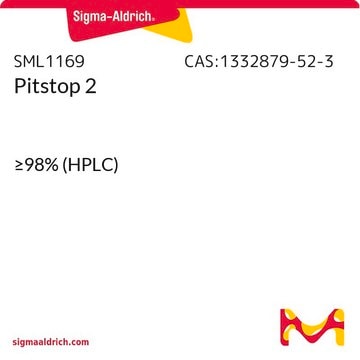215921
Chlorpromazine, Hydrochloride
Inhibits calmodulin-dependent stimulation of cyclic nucleotide phosphodiesterase (IC₅₀ = 17 µM).
Sinônimo(s):
Chlorpromazine, Hydrochloride
About This Item
Produtos recomendados
Nível de qualidade
Ensaio
≥99% (HPLC)
forma
crystalline solid
fabricante/nome comercial
Calbiochem®
condição de armazenamento
OK to freeze
desiccated (hygroscopic)
cor
off-white
solubilidade
methanol: 10 mg/mL
water: 50 mg/mL
traços de ânion
sulfate (SO42-): ≤0.05%
traços de cátion
Fe: ≤0.001%
heavy metals: ≤0.002%
Condições de expedição
ambient
temperatura de armazenamento
10-30°C
InChI
1S/C17H19ClN2S.ClH/c1-19(2)10-5-11-20-14-6-3-4-7-16(14)21-17-9-8-13(18)12-15(17)20;/h3-4,6-9,12H,5,10-11H2,1-2H3;1H
chave InChI
FBSMERQALIEGJT-UHFFFAOYSA-N
Descrição geral
Ações bioquímicas/fisiológicas
Calmodulin-dependent stimulation of cyclic nucleotide phosphodiesterase
Advertência
Reconstituição
Outras notas
Maor, I., et al. 1995. Arteriosclero. Thromb. Vasc. Biol. 15, 1378.
Netea, M.G., et al. 1995. J. Infect. Dis. 171, 393.
Lindahl, M., and Tagesson, C. 1993. Inflammation17, 573.
Palacios, M., et al. 1993. Biochem. Biophys. Res. Commun. 196, 280.
Yamamoto, H. 1993. Toxicol. Lett. 66, 73.
Vadas, P., et al. 1986. Agents Actions19, 194.
Marshak, P.R., et al. 1985. Biochemistry24, 144.
Informações legais
Palavra indicadora
Danger
Frases de perigo
Declarações de precaução
Classificações de perigo
Acute Tox. 1 Inhalation - Acute Tox. 3 Oral
Código de classe de armazenamento
6.1A - Combustible acute toxic Cat. 1 and 2 / very toxic hazardous materials
Classe de risco de água (WGK)
WGK 3
Ponto de fulgor (°F)
Not applicable
Ponto de fulgor (°C)
Not applicable
Certificados de análise (COA)
Busque Certificados de análise (COA) digitando o Número do Lote do produto. Os números de lote e remessa podem ser encontrados no rótulo de um produto após a palavra “Lot” ou “Batch”.
Já possui este produto?
Encontre a documentação dos produtos que você adquiriu recentemente na biblioteca de documentos.
Nossa equipe de cientistas tem experiência em todas as áreas de pesquisa, incluindo Life Sciences, ciência de materiais, síntese química, cromatografia, química analítica e muitas outras.
Entre em contato com a assistência técnica







